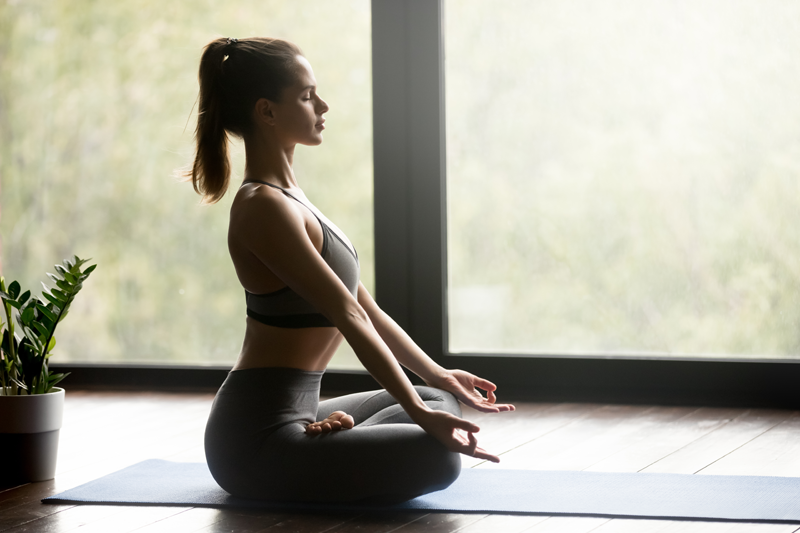
7 Life-Changing Stories of How Yoga Heals
October 3, 2019
Does Yoga and Meditation Help You Live Longer?
October 17, 2019The Art of Non-Attachment in Yoga

Aparigraha is the final Yama in Patanjali’s Eight Limbs of Yoga. When translated from Sanskrit, the word means non-greed or non-attachment. In this article, we explore the art of non-attachment in yoga and find out how we can cultivate its qualities both on and off the yoga mat.
What is Aparigraha?
The Yama can be described as the moral guidelines by which to live. If we follow them, we can learn how to better our relationship with ourselves, our friends and family, and the world around us. As the Yamas are moral codes, they can be applied both on and the mat to help us better various aspects of life.
As well as ‘non-attachment’, Aparigraha translates to ‘non-greed’ and ‘non-possessiveness’. When broken down, the word ‘Graha’ means to seize, to take or to grab, while ‘Pari’ means ‘on all sides’. The last part of the word is the prefix ‘A’; this can be translated to ‘non’. Essentially, Aparigraha teaches us to take only the things we need and to hold onto only what serves us in the present. Once the time is right, we must be able to let go.
This Yama is one of the important teachings in the Bhagavad Gita, the ancient Yogic text. In the text, Krishna says ‘Let your concern be with action alone, and never with the fruits of action. Do not let the results of action be your motive, and do not be attached to inaction’. Essentially, Krishna is saying that we should never be concerned about the outcome of a situation; instead, we should only worry about what we’re doing to work towards it.
For instance, instead of worrying about the outcome of a project at work, a meal we’re preparing, or even a holiday we’re planning, take a moment to enjoy the process. If we worry too much about whether the result will be good enough, we may forget why we started in the first place.
How Can We Implement it?
On the Mat
On the way to a yoga class, most of us look forward to setting an intention, practicing, and breathing to create a peaceful mind. However, halfway through the class, we often lose sight of the real reason we’re there. Suddenly, the practice is no longer focussed on being present and connecting with our inner self, but about pushing ourselves to practice a more complex asana. Thankfully, we can use Aparigraha to fix this.
If you practice yoga outside of the studio, you’ll already know the benefits of hitting the yoga mat at home. The more you practice, the stronger and more flexible you’ll become. However, it can often take a while for the mind to catch up. While the body can reap the benefits immediately, the mind is often too distracted with thoughts about how we can improve at a faster pace. Unfortunately, many people aren’t satisfied with natural, slow-paced improvement and are always looking for something more. Practicing non-attachment can help the mind to improve at the same rate as the body by detaching it from these thoughts and distractions. Instead of thinking about how we can improve, the mind can focus on what we’re doing in the present.

In the Home
How many things do you have around the house that you know you’ll never use again, but you keep just in case? How many clothes do you have in the wardrobe that you’re hanging onto even though you won’t wear them again?
Aparigraha can teach us that we don’t need to hang onto things we no longer use and that we don’t need to buy pointless gadgets, clothing, or homeware ‘just because’. The more material possessions that we hoard, the more we weigh ourselves down with physical and energetic baggage. We are also weighed down by the worry of losing said possessions because of our attachment towards them. Many of us believe that a new object will bring us happiness. This is often based on a feeling of lack that creeps into our minds. Essentially, this ‘lack’ is a feeling of ‘I’m not whole without that new object’ or ‘I’m not good enough without it’. In reality, we are and always will be good enough, regardless of whether we have that new thing or not. By practicing the art of non-attachment, we can lighten the load and move towards a less cluttered mind and environment. To do this, go through your possessions and set aside the things that you haven’t used in the past year. Unless there is a good reason to keep the object, consider selling it or giving it to charity. Next time you feel the urge to buy something new, take a minute to think about why you need it so badly. Unless it’s a necessity, will bring you lasting happiness, or help you live in a more self-reliant way, don’t buy it. Your mind and bank balance will be far better off without unnecessary possessions.
In the Mind
We spend so much time worrying about things that don’t matter. If only we could stop stressing about what might happen, and just enjoy what is happening in the present. Whenever we experience happiness, enter a new relationship, or start a new project, it often comes with a flash of concern about what will come of it, or what will happen when it’s over. While this feeling is completely human, wouldn’t it be better to appreciate the moment for what it is? Instead of being concerned about what will happen in the future, try to enjoy the moment and bask in the positivity for as long as possible. You can’t control what will happen in the future so you might as well enjoy things in the present.
In Summary
In the Bhagavad Gita, Krishna explains the art of non-attachment and says ‘Let your concern be with action alone, and never with the fruits of action. Do not let the results of action be your motive, and do not be attached to inaction’. To practice Aparigraha, put on your yoga pants and allow yourself to enjoy yoga for what it is. By implementing Aparigraha both on and off the mat, we can move towards a happier and healthier existence.

